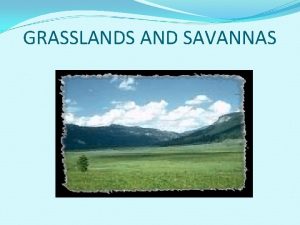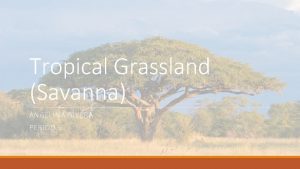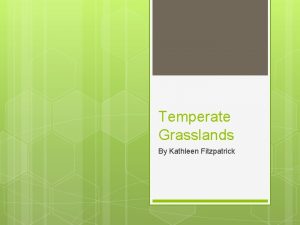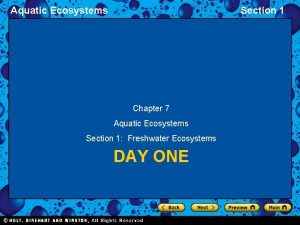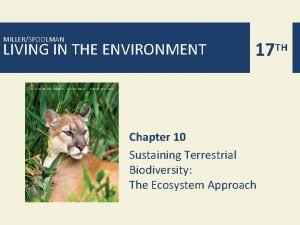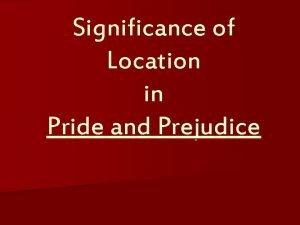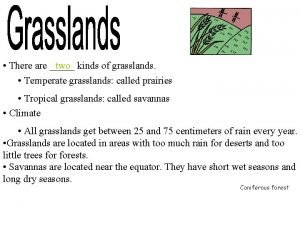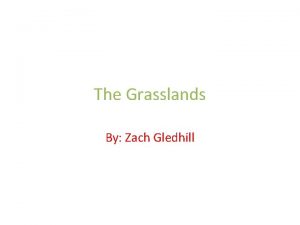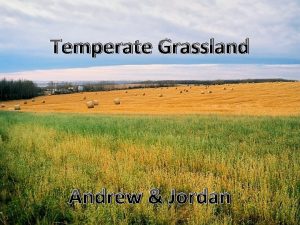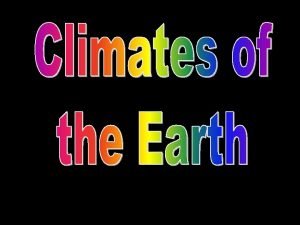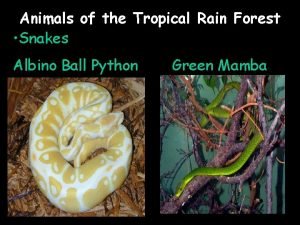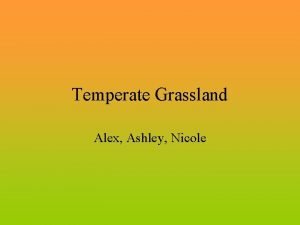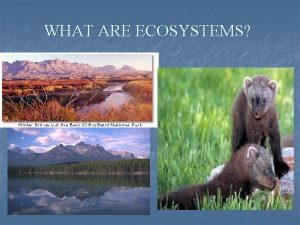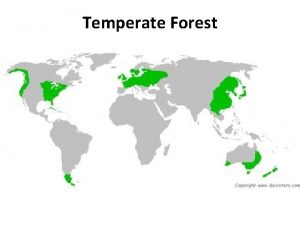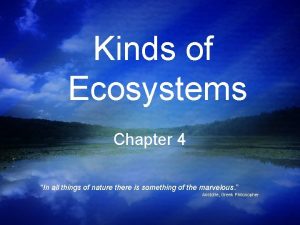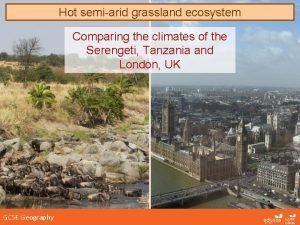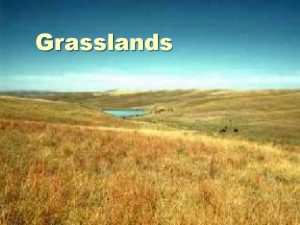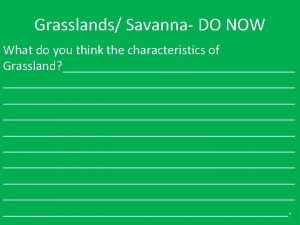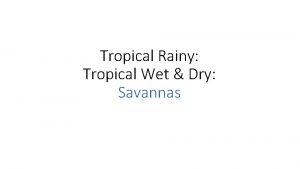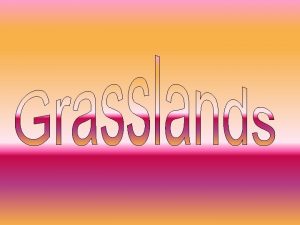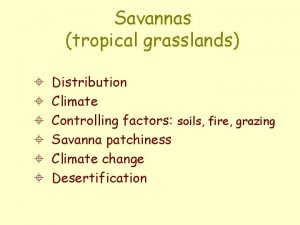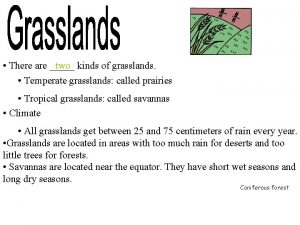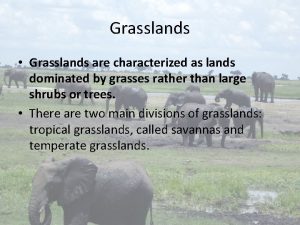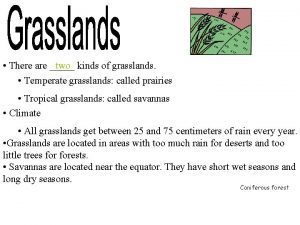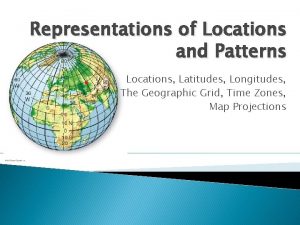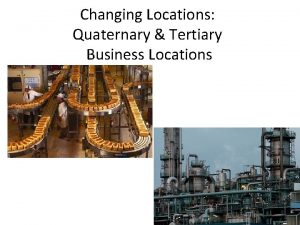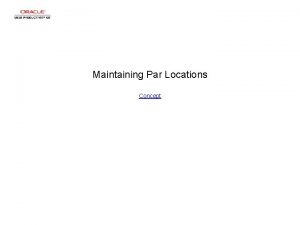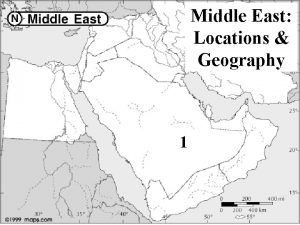GRASSLANDS AND SAVANNAS Locations of Grasslands are located






















- Slides: 22

GRASSLANDS AND SAVANNAS

Locations of Grasslands are located in the middle latitudes, in areas with too much rain for deserts and too little forests (yellow to the right). Savannas are located near the equator (pink to the right). They have short wet seasons and long dry seasons.

Temperate Grasslands In Europe, temperate grasslands are called steppes. In North America, they are called prairies. There are three types of grasses which dominate temperate grasslands: shortgrasses, midgrasses, and tall grasses.

Grass Types Shortgrasses grow where the climate is the driest, and once dominated the Great Plains. Tall grasses appear in the wettest parts of the grassland. Midgrasses fill the spaces between areas of tall grasses and shortgrasses.

Tropical Grasslands baobab acacia Tropical grasslands, also called savannas, cover much of Africa, and parts of India, Australia, and South America. They are covered by clumps of grasses, as short as a few centimeters or as tall as ten feet, with acacia, baobab, and palm trees interspersed.

The climate in a savanna typically consists of warm, wet summers followed by cold, dry winters with heavy frosts. Latitude contributes to climate factors because grasslands are located all over the world, but aren't too far from the equator. Geographic position and prevailing winds are a factor because there are winds blowing over the grasslands that come from all over the continent.

Rainfall 15 to 30 inches a year and is found between temperate forests and deserts that cannot support dense stands of trees Dry season has average of 4 inches of rain Between December and February there is NO rain Frequent droughts Summer there is a lot of rain, causing it to be hot and very humid Grasslands are cooler during the dry season – around 70 F Monsoon rains begin in May in Africa - average of 15 to 25 inches of rainfall during this time Grasslands are known as veldts in South Africa.

Seasons in the Savanna During the dry season, which is exceptionally long and distinct in tropical grasslands, grasses and trees wither and die, many times being consumed in raging fires. When the wet season returns, grasses grow at incredible rates, up to 2. 5 centimeters a day.

Animals in the Grassland Animals in the temperate grassland primarily are smaller grazing animals. Larger animals in the temperate grassland are almost entirely grazing animals. Bison at one point dominated the North American grassland.

Animals in the Savanna Animal life on the savanna is extremely diverse, far more so than the temperate grassland Life consists of everything from small grazers, like hyraxes, to large grazers, like zebras, to predators, like lions, to fast grazers in woody areas, like dik-dik, to slow grazers in watery areas, like hippos.

Animal And Plant Life In the Grasslands Animals Found in the Grasslands

Because Grasslands do not have heavy tree and/or plant life, many large grazing animals are found in the areas. Examples of these include Elephants, Zebras and bison. Other animals found in this region include the Black Rhinoceros, Black-Footed Ferret, Brown Hyena, Giraffe, Greater Prairie Chicken, Prairie Dogs, Lion, Ostrich, Pronghorn and Warthog.

Animal Adaptations As with any biological food chain, the grassland biome allows for every animal to perform a specific niche. The roles in the area can be broadly generalized into Producers (being plants), Predators and Prey.

The adaptations of predators are very similar to one another. They vary in the sense that these different species are in competition with one another, but generally have adapted similar traits. The adaptations of prey are also very characteristic. Small animals, but sometimes in the form of larger animal prey such as Elk, Moose and Zebra, have adapted not only to meet their basic needs, but also for protection from predators.

Unlike grassland animals, plant adaptations are very difficult to generalize There is an extremely large diversity of plant life in the grassland region and every species has individually adapted.

Plants that are dedicated to pollination and consequently attracting insects are the only type of grassland plant that are colourful and bright. In spite of this, a very large portion of grassland plants fall into this category. The Milkweed Flower and Prairie Blazing star have developed visibly bright and vibrant flowers to aid insects in pollination. These plants are usually very small and hidden in the underbrush to avoid being trampled by large animals.

Some plants are dangerous to both animals and humans. . Examples are Poison Ivy and The Stinging Nettle. These plants are focused on nothing but photosynthesis and extracting minerals from the ground and have developed these dangerous characteristics to keep mammals of any size away from them. There are very few trees in the grasslands, however they do exist. They do not grow to be very large however, and almost all reproduce with seeds produced in inedible fruits. Almost all of the fruit in these trees, examples being The Box Elder Tree and Maple Tree are poisonous, to avoid mammals eating them before the seeds are dropped.

Overuse of Grasslands Grassland is the most overused biome in the world. Over 70% of all agriculture occurs in grasslands. The European Steppe and the Great Plains have almost completely disappeared to overdevelopment.

Human Impact Humans have caused great changes on the face of the grasslands across the globe. Many large areas have become developed into farmland, because of their low flat terrain. Often, large fires are started, and quickly tear across the land. Moreover, many animals have been hunted near to extinction (ie. Lions, elephants, bison) Thankfully, the hunting of such animals has been banned. Only 1% of the total grasslands are protected today, but governments are finally more aware of the issue at hand.

National parks are an excellent way to preserve these lands. Erosion and pollution have become major causes of destruction in the grasslands. Human industrial waste has become the leading danger to the development of the grasslands.

Grasslands in the Future More than 60% of the grassland biome has already been modified forestry and agriculture playing the largest roles. In South Africa only 2. 23% of the Grassland Biome is formally conserved. The grassland biome is the least conserved, and the most transformed of all the biomes of the world. It is predicted that within the next 100 years, the grasslands could be wiped out of existence. That would mean the eradication of some of the world’s most rare and beautiful species. If steps are not taken to protect one of the most delicate systems on earth it will not be there for the enjoyment of future generations.

Savannas of South Africa
 Locations of grasslands
Locations of grasslands Mikael ferm
Mikael ferm Where are tropical grasslands located
Where are tropical grasslands located Grassland found in south america
Grassland found in south america What two locations are marine ecosystems usually located?
What two locations are marine ecosystems usually located? Unfenced grasslands in tropical and temperate climates
Unfenced grasslands in tropical and temperate climates Locations in pride and prejudice
Locations in pride and prejudice How to reorder artboards in illustrator
How to reorder artboards in illustrator Tropical wet and dry locations
Tropical wet and dry locations Memory locations and addresses in computer organization
Memory locations and addresses in computer organization Nc license and theft bureau offices
Nc license and theft bureau offices Two temperate grasslands
Two temperate grasslands Temperate grasslands map
Temperate grasslands map Adaptations in temperate grasslands
Adaptations in temperate grasslands Climograph graph
Climograph graph Name of grasslands
Name of grasslands Temperate grassland animal adaptations
Temperate grassland animal adaptations Non living things in grassland
Non living things in grassland Grasslands plants
Grasslands plants Temperate forest biotic factors
Temperate forest biotic factors Temperate grasslands plant adaptations
Temperate grasslands plant adaptations Types of grasslands comparing climatographs
Types of grasslands comparing climatographs Tpr/bp/vitals chart
Tpr/bp/vitals chart
